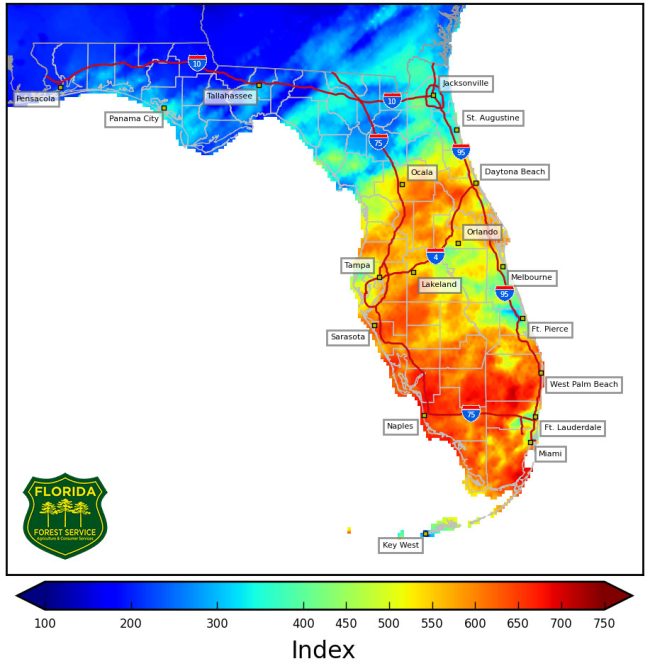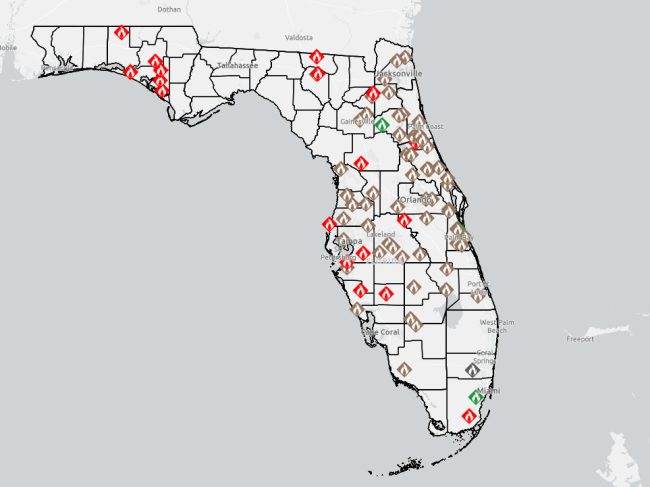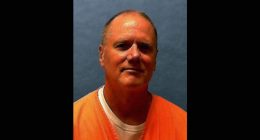
A fire that started about 3 p.m. Thursday (April 24) on the west side of Flagler County quickly grew from 7 to 250 acres in a matter of hours, reflecting the brittle conditions resulting from increasingly dry ground. The blaze, identified as the Cowpen 2 fire, is still burning but is 90 percent contained this morning.
There were no injuries, no structures were threatened and no evacuations. The fire is in an isolated part of western Flagler County, off County Road 305. Crews from the Florida Forest Service (Forestry), with the assistance of Flagler County Fire Rescue, worked all night to contain the fire.
The county declared a burn ban on Wednesday. Fire officials urge residents to be mindful of the ban and to call 911 to report smoke column sightings. The drought index in Flagler County is now 505 as an average (it is lower in the northern part of the county, higher in its south and west), increasing by six points overnight. The drought index is on an 800-point scale, with zero reflecting saturated grounds and 800 reflecting desert-like conditions. Wildfires tend to pop up more easily when the index is above 500. There is no rain in the forecast.

“We had the county’s UAS drone team out last night with their infrared imaging to help us get an exact picture of what this fire looks like, and to make a plan moving forward,” said Fire Chief Michael Tucker.
Fire Rescue Battalion Chief Brady Barry provided a Friday morning update.
“We will continue to assist Forestry with two attack (brush) trucks, one water tender, and one battalion,” Barry said. “Forestry, the lead agency, has the bulk of the equipment and resources.” Those resources include a Heavy Equipment Task Force with multiple bulldozers to cut fire lines, and an Engine Strike Team of six brush trucks.
FireFlight, the county’s emergency helicopter–originally acquired to spot and fight wildfires–on Thursday started dropping water on the fire. It was joined shortly thereafter by a Forestry helicopter out of Ocala and a fixed-wing aircraft. The fixed-wing plane monitored the two helicopters to ensure they kept a safe distance from each other as they traveled back and forth from the water-dipping location and the fire.
“That fixed wing is very important to the operation,” Barry said.
For now, the county has not requested the support of the Palm Coast Fire Department, Fire Chief Kyle Berryhill said. “All three agencies are in communication about the wildfire situation in the county and collaborated on the recommendation for the burn ban,” he said.
All fire officials urge residents to remember how dry it has been and to be diligent with fire safety habits. “The conditions are becoming favorable for rapid fire growth so this action will help,” Tucker said. “In addition to the ban on burning, remember that a good offense is the best defense. Clear the area around your house of anything that will go up in flames easily – including stacks of firewood, portable propane tanks, and dead, dry vegetation.”

The burn ban prohibits the following:
- Discharge/use of fireworks, sparklers, flares, or other items containing any “explosive compound”
- Open burning, including the use of fire pits and containers
- Outdoor cookers and grills unless continuously attended by an adult
- Throwing matches, cigarettes, or other burning materials from vehicles
- Parking vehicles with catalytic converters in high grassy areas
The rule of thumb for taking personal protective measures, accepted by a variety of fire prevention agencies, including the National Fire Protection Association, is that all flammable items within 30 feet of a structure should be removed. Homeowners should clear roofs, eaves, gutters, wood decks and patios of leaves, needles, and other debris.
“Additionally, do not store things under decks or porches, and consider using rocks or gravel in those areas instead grass or mulch,” Tucker said. “Wood-driven fires, like brushfires, create embers that can be carried quite far, and tend to find their way to the same nooks and crannies where leaves accumulate.”
Barbecue coals should be fully extinguished before adding them to garbage receptacles.










